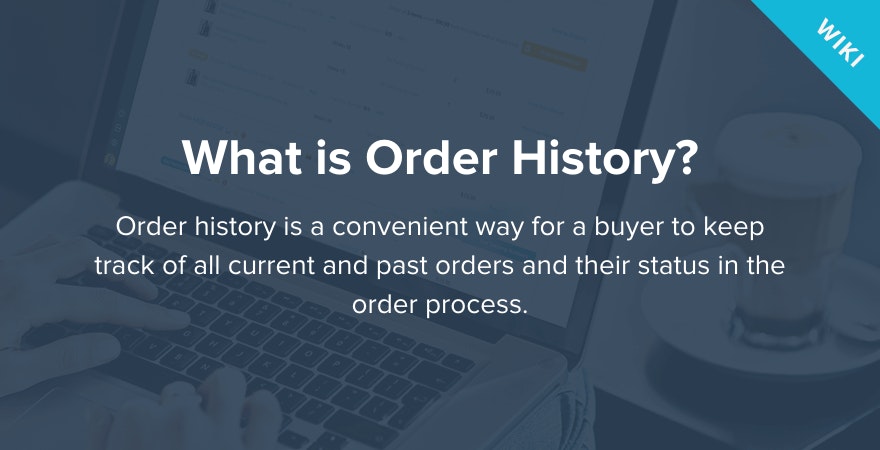
Order History



What is order history?
Order history is a convenient way for a buyer to keep track of the status of all current and past orders in the order process. For merchants, it's a comprehensive record that includes details such as the purchased products, the purchase date and time, the spent amount, the payment method, and the order status.
This data provides a valuable snapshot of a customer profile; their buying behavior, preferences, and engagement with your business. It's through this record that we can trace the journey of an order, from the moment it's placed to its final delivery, a journey marked by changes in order status.
→ Click Here to Launch Your Online Business with Shopify
What is an order status?
Order status is a label that indicates the current position or stage of an order within the operational workflow of an ecommerce business. It provides real-time information about the progress of an order from the moment it's placed until it's delivered to the customer.
Typical order statuses include:
- Active: The order has been placed, buit is not yet marked as complete.
- Pending: The order is awaiting processing.
- Processed: The order has been processed and is ready for shipment.
- Shipped: The order has been shipped and is on its way to the customer.
- Cancelled: The order has been cancelled, typically by the customer or due to a stock issue.
- Returned: The customer has returned the order, and it's back with the merchant.
Why is order history important?
For several reasons, order history serves as a valuable resource for ecommerce merchants:
- Customer behavior insights: Order history can reveal patterns in a customer's purchasing behavior, such as their preferred products, spending habits, and purchase frequency. These insights can inform marketing strategies and product recommendations.
- Inventory management: By analyzing order history, merchants can predict product demand and manage inventory more effectively. This can help prevent stockouts and overstock situations.
- Customer service: Order history provides context for customer inquiries or complaints, allowing customer service representatives to provide more accurate and personalized assistance.
- Sales forecasting: Historical order data can be used to predict future sales trends, helping businesses plan for growth and manage resources.
- Personalized marketing: Order history can inform personalized marketing efforts, such as email campaigns, by highlighting products a customer may be interested in based on their past purchases.
In essence, order history is not just a record of past transactions, but a tool that can drive strategic decision-making and improve overall business performance.
Using order history to improve sales
Order history is a treasure trove of insights that can be leveraged to drive sales. By analyzing patterns in your customers' purchasing behavior, you can tailor your sales strategies to meet their needs and preferences more effectively.
Here are some ways order history can be used to boost sales:
- Personalized recommendations: Use a customer's order history to recommend products they might be interested in. If a customer frequently buys a certain type of product, suggesting similar items can encourage additional purchases.
- Targeted promotions: Order history can help identify customers who haven't made a purchase in a while. Target these customers with special offers or discounts to re-engage them.
- Seasonal sales forecasting: Analyze order history to identify seasonal trends in your sales. Use this information to stock up on popular items during peak seasons and run timely promotions.
- Upselling and cross-Selling: Use order history to identify opportunities for upselling and cross-selling. If a customer often buys a particular item, you might suggest a higher-end version of the product (upselling) or a related product that complements their purchase (cross-selling).
- Improving customer retention: Regular analysis of order history can help identify customers who are at risk of churning. You can then implement strategies to improve their experience and retain them.
Using order history to improve customer satisfaction
Order history can also play a significant role in enhancing customer satisfaction. By understanding your customers' purchasing habits and preferences, you can provide a more personalized and satisfying shopping experience. Here's how:
- Personalized shopping experience: Use order history to personalize the shopping experience for each customer. By recommending products based on their past purchases, you can make shopping more convenient and enjoyable for your customers.
- Improved customer service: Order history can provide valuable context when dealing with customer inquiries or complaints. By understanding a customer's past interactions and purchases, customer service representatives can provide more accurate and personalized assistance.
- Tailored marketing communications: Use order history to tailor your marketing communications to each customer's interests and preferences. This can make your communications more relevant and engaging, leading to higher customer satisfaction.
- Predicting and meeting customer needs: Analyzing order history can help you predict future customer needs and preferences. This can guide product development and inventory management, ensuring you can meet your customers' needs effectively.
- Building customer loyalty: By using order history to provide a personalized and satisfying shopping experience, you can build stronger relationships with your customers, leading to increased loyalty and repeat purchases.
By harnessing the insights from order history, you can make informed decisions that not only boost sales but also improve customer satisfaction. Effectively utilizing this data allows you to create a more personalized and engaging shopping experience, fostering stronger relationships with your customers. This dual focus on driving sales and enhancing customer satisfaction is key to building a resilient and successful ecommerce business.